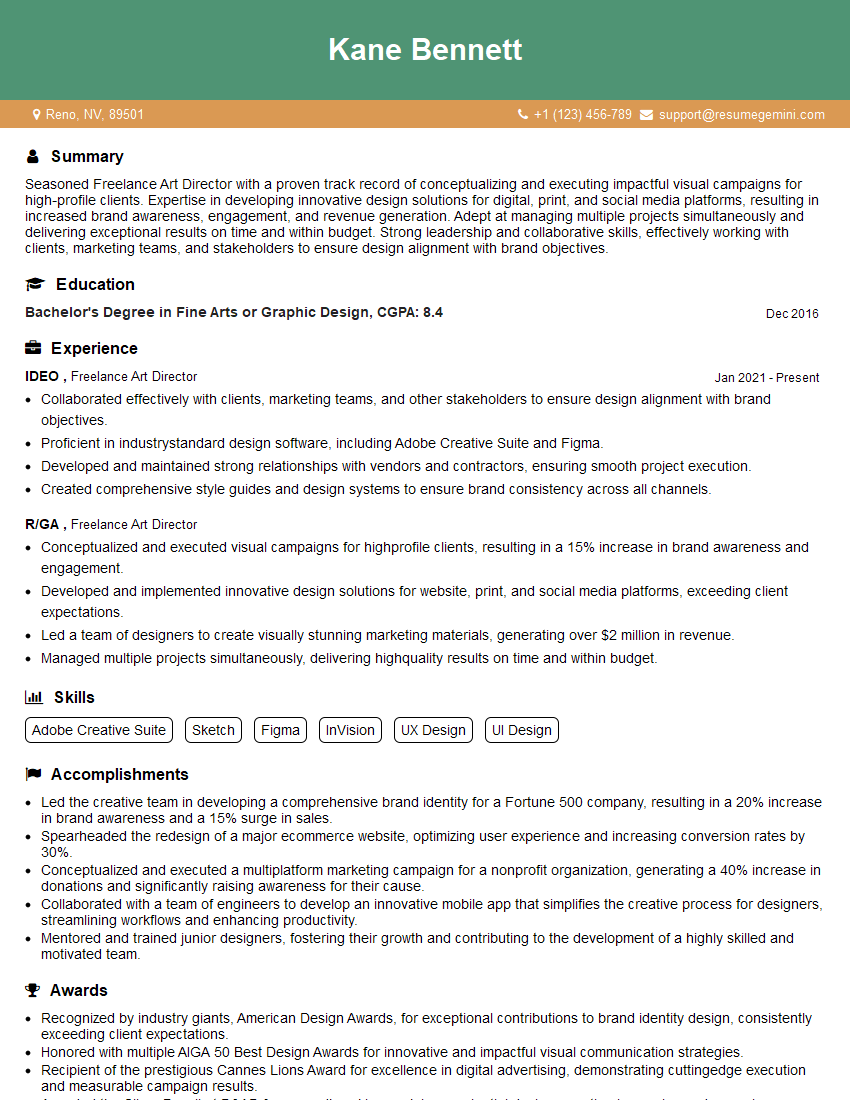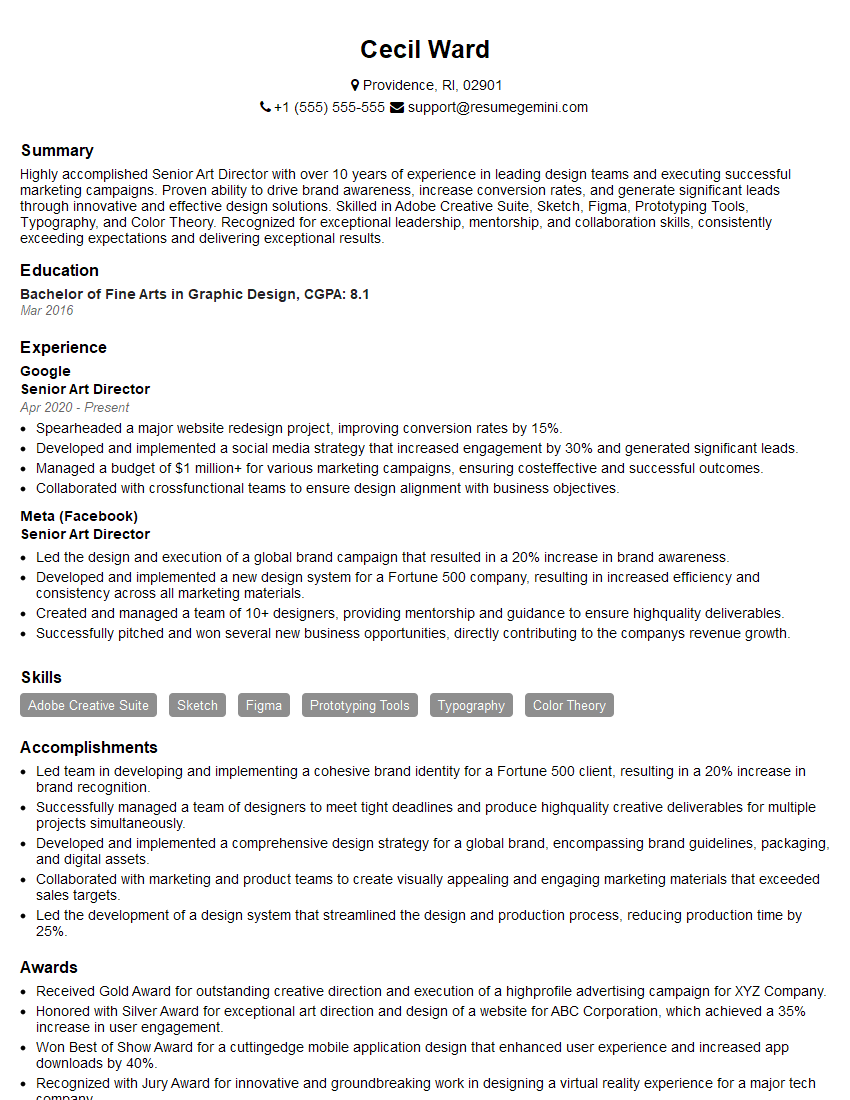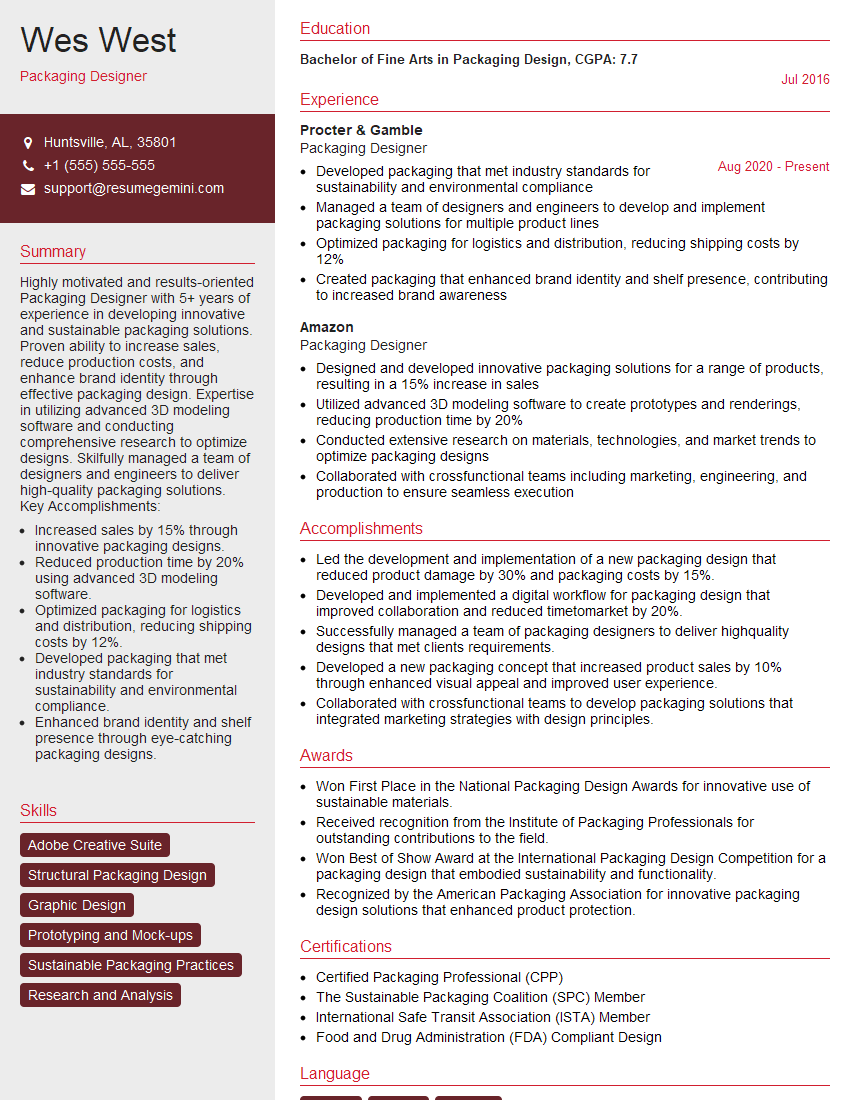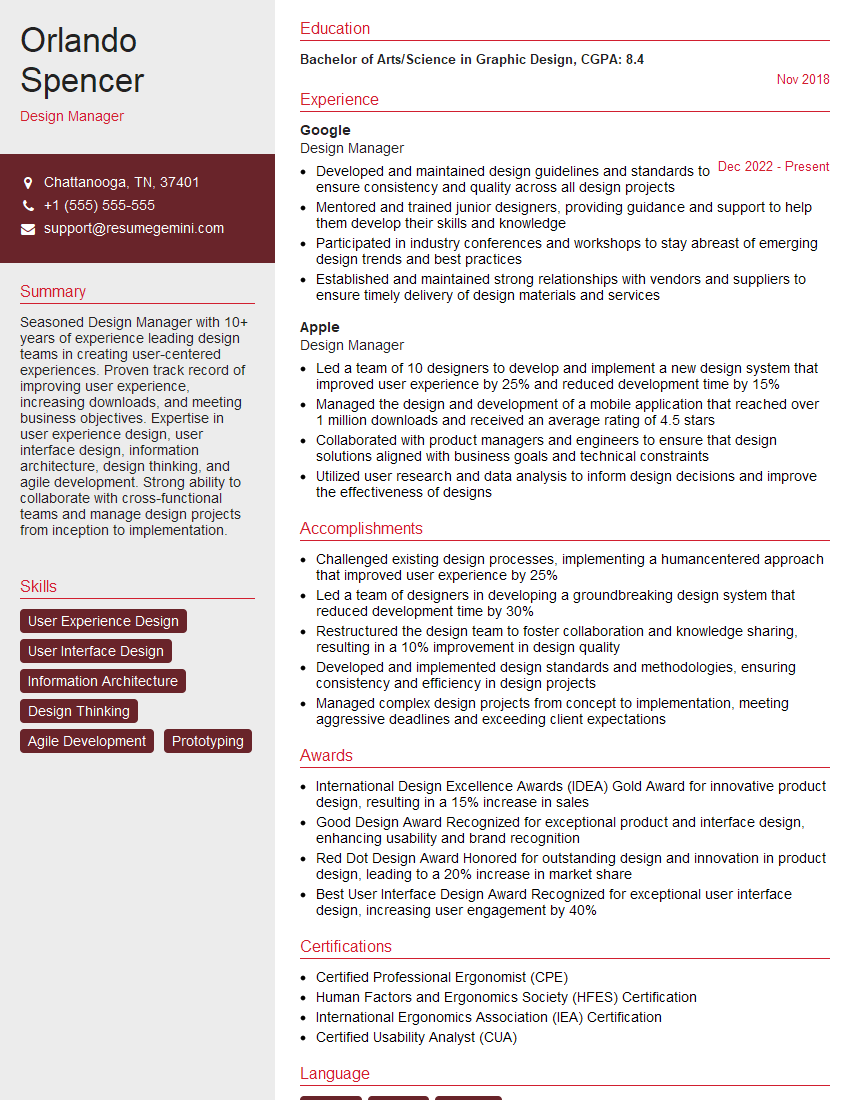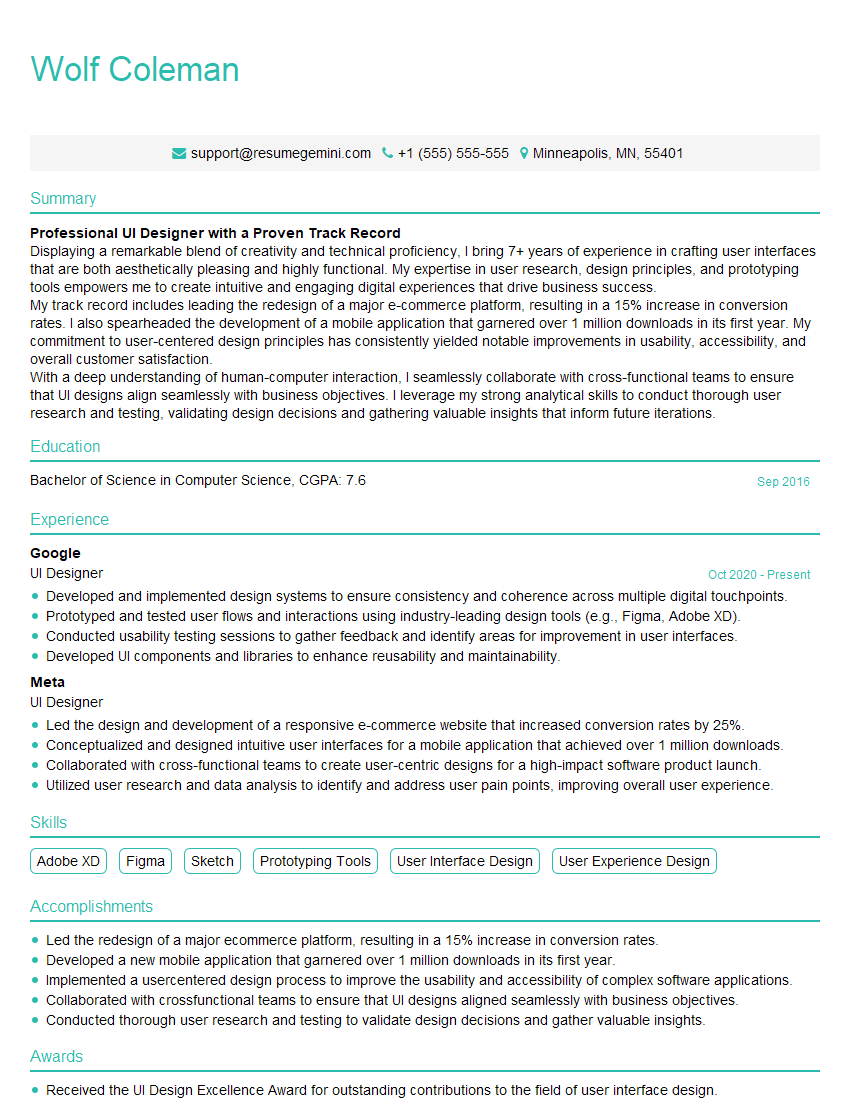The thought of an interview can be nerve-wracking, but the right preparation can make all the difference. Explore this comprehensive guide to Experience in art direction interview questions and gain the confidence you need to showcase your abilities and secure the role.
Questions Asked in Experience in art direction Interview
Q 1. Describe your experience with art direction in different mediums (print, digital, video).
My experience in art direction spans across print, digital, and video mediums, each demanding a unique approach. In print, I’ve worked on everything from brochures and magazine layouts to packaging design, focusing on typography, color palettes, and image selection to create impactful, visually compelling materials. For instance, I recently redesigned the packaging for a local coffee roaster, increasing their shelf appeal by 25% according to their sales data. This involved careful consideration of the target audience and the brand’s overall aesthetic, resulting in a design that was both visually striking and highly communicative of the product’s quality.
My digital art direction experience encompasses website design, social media campaigns, and online advertising. Here, the focus shifts towards user experience (UX) and ensuring visual consistency across multiple platforms. For example, I led the redesign of a non-profit’s website, significantly improving its navigation and user engagement, as measured by increased website traffic and donation conversions. This required a deep understanding of current design trends in web UI and the use of responsive design principles.
Finally, in video, I’ve collaborated on several projects, from short promotional clips to longer-form documentaries, overseeing the visual style, storyboarding, and overall aesthetic direction. For one project involving a corporate training video, I worked closely with the cinematographer and editor to create a visually engaging and easily digestible narrative, resulting in overwhelmingly positive feedback from employees.
Q 2. Explain your process for developing a visual concept from initial brief to final execution.
My process for developing a visual concept is iterative and collaborative. It begins with a thorough understanding of the client brief, identifying the key objectives, target audience, and brand guidelines. I then conduct thorough research, exploring relevant visual trends and existing brand assets. Next, I generate multiple mood boards and concept sketches, exploring different stylistic approaches. These are then presented and discussed with the team and client to refine the concept.
Once a preferred direction is established, I create detailed mockups or storyboards, incorporating specific typography, color palettes, imagery, and layout. This stage involves constant feedback and iteration to ensure the final design aligns perfectly with the client’s vision and project goals. The final step involves the actual execution of the design, working closely with designers and other collaborators to ensure seamless integration and high-quality output.
This process, while seemingly linear, is highly flexible, adapting to the unique demands of each project. Think of it as building a house – you start with blueprints (the brief), refine the design (concept sketches), construct the frame (mockups), and then furnish the house (final execution).
Q 3. How do you manage creative differences within a design team?
Managing creative differences within a team requires open communication, active listening, and a focus on collaborative problem-solving. I believe in fostering an environment where everyone feels comfortable expressing their ideas, regardless of seniority. When disagreements arise, I facilitate discussions, ensuring everyone’s perspective is heard and understood. We often use collaborative tools like shared online documents and design platforms to visually compare different approaches.
The key is to focus on the project goals and find common ground. Sometimes, compromise is necessary; other times, a creative solution emerges by combining elements from different ideas. For example, in one project, a designer had a strong preference for a minimalist approach, while another preferred a more vibrant style. By combining elements from both styles, we ended up with a unique and impactful design that exceeded our expectations.
Q 4. Describe your experience with client presentations and feedback incorporation.
Client presentations are crucial for conveying the design concept and securing approval. I prepare comprehensive presentations, showcasing the design process, rationale behind choices, and the overall value proposition. I use visuals effectively, presenting mood boards, mockups, and prototypes to illustrate the design’s aesthetic and functionality. I also focus on data-driven insights and user feedback to support my recommendations.
Incorporating client feedback is essential. I actively listen to their concerns and suggestions, asking clarifying questions to understand their perspective. I then work collaboratively to address their feedback, making necessary revisions and demonstrating how these changes align with the project goals. This iterative process ensures the final design meets both the client’s vision and project requirements. I find that proactively soliciting feedback throughout the design process, rather than just at the end, helps manage expectations and avoids major revisions later on.
Q 5. How do you stay current with design trends and technologies?
Staying current in design requires a proactive and multi-faceted approach. I regularly follow influential design blogs, publications, and online communities like Behance and Dribbble. I also attend industry conferences and workshops, networking with fellow designers and learning about emerging trends. Additionally, I actively participate in online courses and webinars to enhance my skills and knowledge in new design tools and technologies.
Beyond simply keeping abreast of trends, I analyze them critically, understanding the underlying design principles and their applicability to different projects. For instance, while I’m aware of the current popularity of certain design styles, I carefully consider whether they align with the specific project’s goals and brand identity before incorporating them.
Q 6. What software and tools are you proficient in (Adobe Creative Suite, Sketch, Figma, etc.)?
I’m proficient in the Adobe Creative Suite (Photoshop, Illustrator, InDesign), as well as Figma and Sketch. My expertise extends beyond just the software itself; I understand how to leverage each tool’s unique capabilities to optimize the design process and achieve optimal results. For example, I use Illustrator for creating vector-based illustrations and logos, Photoshop for image editing and retouching, and InDesign for page layout and publication design. Figma and Sketch are invaluable for collaborative design work and prototyping, particularly in digital projects.
My skillset also includes proficiency in other relevant tools like prototyping software, video editing software, and 3D modeling software, depending on the specific project requirements.
Q 7. How do you ensure brand consistency across different design projects?
Maintaining brand consistency across multiple projects requires a systematic approach, starting with the development of a comprehensive brand style guide. This guide acts as a central repository for all brand elements, including logos, typography, color palettes, imagery guidelines, and voice and tone. I ensure that all design projects adhere strictly to this guide, creating a cohesive and recognizable brand identity across all platforms.
I often use design systems and component libraries (within tools like Figma) to ensure consistent application of brand elements. This streamlines the design process and reduces the risk of inconsistencies. Furthermore, I regularly review completed projects to ensure adherence to the style guide and make necessary adjustments as needed. Think of it like a recipe – the style guide is the recipe, and each project is a dish that must follow the recipe’s instructions to maintain a consistent taste and quality.
Q 8. Describe a time you had to overcome a creative challenge.
One significant creative challenge arose during a campaign for a sustainable fashion brand. The brief called for visually stunning imagery that also conveyed the brand’s ethical and environmental commitment. The initial concepts, while aesthetically pleasing, lacked the impact needed to resonate with the target audience’s values.
To overcome this, I employed a multi-pronged approach. First, I revisited the brand’s core values, spending time understanding the nuances of their production methods and sustainability initiatives. This deeper understanding informed a shift in my artistic direction. Instead of focusing solely on polished, aspirational imagery, I incorporated raw, unfiltered elements – images showcasing the artisans’ hands, the natural landscapes where the materials originated, and the processes involved in creating the garments. This created a powerful narrative that connected the product’s aesthetics with its ethical sourcing and production. This approach resulted in a campaign that not only looked stunning but also effectively communicated the brand’s message, significantly improving engagement metrics.
Q 9. How do you prioritize multiple projects with competing deadlines?
Prioritizing multiple projects with competing deadlines requires a structured and adaptable approach. I utilize a project management system that combines task prioritization matrices (like Eisenhower’s Urgent/Important matrix) with agile methodologies. This means constantly reassessing priorities based on factors such as deadlines, client importance, and project impact.
For example, I might use a Kanban board to visualize all ongoing tasks, color-coding them by priority and deadline. This gives me a clear overview, allowing me to quickly identify bottlenecks and reallocate resources. Regular check-ins with clients and team members are also crucial to ensure everyone’s aligned and to address emerging challenges promptly. Open communication prevents unexpected delays and ensures timely project completion.
Q 10. What’s your experience with budgeting and resource allocation in design projects?
Budgeting and resource allocation are integral to successful design projects. My experience involves creating detailed budgets that encompass all project phases – from initial research and concept development to final production and delivery. This includes forecasting costs related to photography, illustration, graphic design software, printing, and potential external collaborations.
I start by breaking down the project into manageable tasks and estimating the time and resources each will require. I then research and compare prices for different services and materials to identify cost-effective solutions without compromising quality. Regular budget monitoring and reporting are crucial, enabling me to identify potential overruns early and adjust accordingly. For example, if a specific photoshoot is exceeding the allocated budget, I might explore alternative approaches, such as utilizing existing stock photography or modifying the shoot scope to align with the budget.
Q 11. How do you ensure the accessibility of your designs?
Ensuring accessibility in my designs is a fundamental aspect of my process. This involves adhering to WCAG (Web Content Accessibility Guidelines) standards and considering diverse user needs, including those with visual, auditory, motor, and cognitive impairments.
This starts with using sufficient color contrast ratios between text and backgrounds, ensuring legible font sizes, providing alternative text for images (alt text), and offering captions and transcripts for video and audio content. I also consider keyboard navigation and screen reader compatibility when designing interfaces. For instance, I might test designs using assistive technologies or consult with accessibility experts to identify and address potential barriers. Regular usability testing with diverse participants is key to validating the accessibility of my work.
Q 12. Explain your understanding of user experience (UX) principles in art direction.
UX principles are paramount in art direction. While art direction focuses on the aesthetic aspects, it’s inseparable from the user experience. A beautiful design is ineffective if it doesn’t serve the user’s needs and goals. I strive to create designs that are not only visually appealing but also intuitive, efficient, and enjoyable to interact with.
For example, the placement of elements on a webpage or the visual hierarchy of information must follow UX best practices to guide the user’s eye and make it easy to find what they’re looking for. Clear visual cues, consistent branding, and intuitive navigation are crucial for a positive user experience. I collaborate closely with UX designers to ensure the art direction supports and enhances the overall user journey.
Q 13. How do you incorporate user feedback into your design process?
User feedback is crucial for iterative design improvement. I incorporate user feedback throughout the design process, from early concept stages to final implementation. This often involves conducting user testing, surveys, and A/B testing to gather data on user preferences, pain points, and areas for improvement.
For instance, during user testing, I might observe how users interact with a prototype, identifying any points of confusion or frustration. This data informs design iterations, ensuring that the final product is intuitive and meets user expectations. Analyzing feedback allows for evidence-based decision-making, ultimately resulting in more effective and user-centered designs.
Q 14. What are your strategies for conducting design research?
My design research strategies are multifaceted, combining quantitative and qualitative methods. This might involve user interviews, surveys, competitive analysis, and usability testing to understand user needs, preferences, and behaviors. I also leverage data analytics to track user engagement with existing designs and identify areas for optimization.
For example, I might conduct user interviews to gather in-depth insights into user pain points and motivations, complementing this with A/B testing to compare the effectiveness of different design variations. Competitive analysis helps me understand industry best practices and identify opportunities for differentiation. The data collected through these methods informs design decisions, ensuring that my work is both innovative and user-centered.
Q 15. Explain your experience with A/B testing and iterative design.
A/B testing and iterative design are fundamental to ensuring a design’s effectiveness. A/B testing involves presenting two variations (A and B) of a design element – perhaps a button color or headline – to different user groups and measuring which performs better based on metrics like click-through rates or conversion rates. Iterative design, on the other hand, is a cyclical process where you design, test, analyze results, and refine your design based on what you learn. It’s not a linear process; it’s a continuous improvement loop.
For example, in a recent e-commerce project, we A/B tested two versions of a product page. Version A featured a large hero image, while Version B used a carousel of smaller images. A/B testing revealed that Version A resulted in a 15% higher conversion rate. This data informed the iterative design process, leading us to refine the hero image further based on user feedback collected during the testing phase. We then iterated on other elements, such as call-to-action button placement and text, using similar testing methodologies.
This iterative approach ensures that the final design is data-driven and user-centered, maximizing its effectiveness and achieving the desired outcomes. It’s not just about aesthetics; it’s about functionality and achieving business goals.
Career Expert Tips:
- Ace those interviews! Prepare effectively by reviewing the Top 50 Most Common Interview Questions on ResumeGemini.
- Navigate your job search with confidence! Explore a wide range of Career Tips on ResumeGemini. Learn about common challenges and recommendations to overcome them.
- Craft the perfect resume! Master the Art of Resume Writing with ResumeGemini’s guide. Showcase your unique qualifications and achievements effectively.
- Don’t miss out on holiday savings! Build your dream resume with ResumeGemini’s ATS optimized templates.
Q 16. Describe your experience managing a team of designers.
Managing a design team requires a blend of leadership, mentorship, and project management skills. My experience involves fostering a collaborative environment where each designer’s strengths are utilized effectively. This includes regular team meetings to discuss project progress, challenges, and brainstorm solutions. I also focus on providing individual mentorship, tailoring my guidance to each designer’s skill level and career aspirations.
For instance, when managing a team working on a rebranding project for a major corporation, I assigned tasks based on individual expertise. Senior designers led the development of the brand guidelines, while junior designers focused on creating initial design concepts. I ensured regular check-ins to monitor progress, provide constructive feedback, and offer support as needed. Open communication and regular feedback were key to the team’s success and overall project delivery.
Delegation isn’t simply assigning tasks; it’s about empowering individuals and building trust within the team. I believe in providing designers with the autonomy to explore creative solutions while ensuring alignment with the overall project goals.
Q 17. How do you give constructive feedback to designers?
Constructive feedback is crucial for a designer’s growth. My approach is always to focus on the work, not the person. I begin by highlighting the positive aspects of the design, acknowledging the designer’s effort and identifying strengths. Then, I address areas for improvement using the ‘sandwich’ method: positive feedback, constructive criticism, and another positive comment. I frame criticism as suggestions, focusing on specific elements and offering actionable solutions rather than vague statements.
For example, instead of saying, ‘This design is messy,’ I might say, ‘The layout feels a bit cluttered. Perhaps we could try grouping related elements together using whitespace to create a clearer visual hierarchy. However, I really like the color palette you’ve chosen—it’s very on-brand.’ I also encourage designers to ask questions and engage in a dialogue to ensure the feedback is understood and incorporated effectively.
Ultimately, my goal is to help designers improve their skills, build confidence, and deliver high-quality work.
Q 18. How do you delegate tasks effectively within a design team?
Effective task delegation in a design team hinges on understanding each designer’s skills and strengths. I begin by clearly defining the scope of each task, outlining specific goals, deadlines, and expected deliverables. I then consider individual capabilities and project requirements to assign tasks accordingly. For instance, a designer with strong illustration skills might be tasked with creating visual assets, while a designer skilled in typography might focus on developing the brand’s font system.
I utilize project management tools to track progress, assign deadlines, and facilitate communication. This ensures transparency and accountability. Regular check-ins are crucial to address any challenges or roadblocks, providing support and guidance as needed. I also encourage collaboration and knowledge sharing within the team, fostering a spirit of teamwork and mutual support.
The key is to balance clear direction with empowering designers to take ownership of their tasks. This fosters independence and encourages creative problem-solving.
Q 19. What is your approach to creating a cohesive brand identity?
Creating a cohesive brand identity involves a holistic approach, weaving together visual elements, messaging, and overall brand personality. I begin by thoroughly understanding the brand’s mission, values, target audience, and competitive landscape. This research forms the foundation upon which the brand’s visual identity will be built.
Next, I develop a mood board to capture the essence of the brand—the feeling and style it should evoke. This informs the selection of colors, typography, imagery, and overall aesthetic. Consistency is key; a style guide is developed outlining specific guidelines for logo usage, color palettes, typography, and imagery. This document serves as a reference point for all future design work, ensuring brand consistency across all platforms.
For example, when developing a brand identity for a sustainable clothing company, we used earthy tones, handcrafted fonts, and imagery of natural landscapes to convey the brand’s values of environmental responsibility and craftsmanship.
A cohesive brand identity is more than just a logo; it’s a strategic approach to crafting a recognizable and memorable brand experience.
Q 20. Explain your understanding of color theory and typography.
Color theory and typography are essential components of effective visual communication. Color theory involves understanding how colors interact and evoke certain emotions. For example, warm colors like red and orange often convey energy and excitement, while cool colors like blue and green suggest calmness and serenity. Understanding color harmony (e.g., complementary, analogous, triadic) is vital for creating visually appealing and balanced designs.
Typography concerns the art and technique of arranging type. It involves selecting appropriate fonts, sizes, weights, and spacing to enhance readability and create a desired aesthetic. Choosing the right font family can significantly impact a brand’s personality and message. For example, a serif font might convey tradition and sophistication, while a sans-serif font might appear modern and clean. Effective typography ensures that text is legible, easily scannable, and visually appealing.
I use this knowledge to create visual hierarchies, guide the reader’s eye, and establish the overall tone and style of a design. The interplay of color and typography is crucial in conveying the brand message effectively.
Q 21. How do you measure the success of your design projects?
Measuring the success of a design project goes beyond simply delivering a visually appealing result. It involves setting clear, measurable goals at the outset. These could include increasing brand awareness, improving website conversion rates, boosting user engagement, or enhancing customer satisfaction. Once the project is launched, I monitor key performance indicators (KPIs) to track progress towards these goals.
These KPIs might include website traffic, bounce rates, time spent on page, conversion rates, social media engagement, and customer feedback. We use analytics tools like Google Analytics and other platforms to gather data and assess the effectiveness of our designs. This data-driven approach allows us to identify what is working well and what needs improvement. Regular reporting and analysis keep us informed and ensure we’re constantly refining our designs to achieve optimal results.
For example, after launching a redesigned website, we tracked a 20% increase in conversion rates, indicating the success of our design improvements. User testing and feedback also played a role in validating the effectiveness of our work.
Q 22. How familiar are you with design systems and style guides?
Design systems and style guides are the cornerstones of consistent and efficient design. A design system is a comprehensive collection of reusable components, patterns, and guidelines that define a brand’s visual language and user interface. Think of it as a living, breathing library of design assets. A style guide, while often part of a design system, focuses specifically on the visual aspects – typography, color palettes, imagery, and branding elements.
My familiarity extends to both creating and implementing them. For example, in my previous role at [Previous Company Name], I was instrumental in developing a design system for their new web application. This involved defining component libraries using Figma, creating detailed specifications for typography and color palettes, and establishing clear guidelines for iconography and imagery. This resulted in a significant increase in design consistency and development efficiency.
- Experience with design systems tools: Figma, Sketch, Adobe XD, Zeroheight
- Experience with style guide creation: Defining typography, color palettes, layout grids, component libraries.
Q 23. Describe your experience with creating mockups and prototypes.
Creating mockups and prototypes is crucial for visualizing and testing design concepts before development. Mockups are static representations, often low-fidelity, focusing on visual layout and branding. Prototypes, on the other hand, add interactivity, allowing users to simulate interactions and provide feedback.
I’m proficient in various tools, including Figma, Sketch, and Adobe XD, to create both high-fidelity and low-fidelity mockups and interactive prototypes. For instance, on a recent project for [Previous Client Name], I developed a series of interactive prototypes to test different user flows for their e-commerce platform. This involved creating clickable components, simulating transitions, and incorporating user feedback to refine the design before it went to development.
- Tools used: Figma, Sketch, Adobe XD, InVision, Axure RP
- Prototyping methods: Clickable prototypes, interactive animations, user testing.
Q 24. How do you handle tight deadlines and unexpected changes?
Handling tight deadlines and unexpected changes is a given in the fast-paced world of design. My approach is based on prioritizing tasks, adapting to new information quickly, and maintaining clear communication.
When faced with a tight deadline, I utilize time management techniques like creating detailed task lists and prioritizing tasks based on importance and urgency. For unexpected changes, I adapt by re-evaluating the project scope and timeline, and communicating any necessary adjustments to the team immediately. For example, on one project, a key design element was unexpectedly changed three weeks before the launch date. By calmly assessing the impact, communicating with the development team, and prioritizing the necessary changes, we successfully launched the project on time with minimal impact on quality.
- Strategies: Prioritization, time management, clear communication, adaptability.
- Tools: Project management software (Asana, Trello), time tracking tools.
Q 25. Describe your experience with project management methodologies (Agile, Waterfall).
I have experience with both Agile and Waterfall methodologies. Agile focuses on iterative development, flexibility, and collaboration, while Waterfall follows a linear, sequential approach.
In Agile environments, I thrive on the collaborative nature and the opportunity for iterative feedback. I’m comfortable working in sprints, participating in daily stand-ups, and adapting to changing requirements. In Waterfall projects, I appreciate the structured approach and the clear definition of phases. My experience allows me to seamlessly adapt to either methodology based on project needs. I am proficient in utilizing tools such as Jira and Asana to manage tasks and track progress within these frameworks.
Q 26. What is your understanding of copyright and intellectual property?
Understanding copyright and intellectual property is paramount in design. Copyright protects original creative works, including designs, while intellectual property encompasses a broader range of rights, including patents and trademarks.
I am meticulous about ensuring that all designs I create comply with copyright laws and ethical practices. I always obtain proper licensing for any third-party assets used in projects. I am also aware of the importance of maintaining clear ownership and usage rights for my own creative work, and I always ensure proper agreements are in place to protect those rights.
Q 27. How do you maintain a positive and collaborative work environment?
Maintaining a positive and collaborative work environment is essential for success. I believe in open communication, active listening, and mutual respect.
I actively foster collaboration by initiating regular brainstorming sessions, actively seeking input from team members, and offering constructive feedback. I also strive to create a supportive and inclusive atmosphere where everyone feels comfortable sharing their ideas. For example, I often organize team-building activities to enhance communication and camaraderie.
Q 28. What are your career goals related to art direction?
My career goals involve expanding my leadership skills and contributing to innovative projects. I aim to lead and mentor design teams, fostering creativity and developing groundbreaking visual experiences. I’m particularly interested in exploring emerging technologies and their applications in art direction, such as VR/AR and AI-powered design tools.
Key Topics to Learn for Your Art Direction Interview
- Visual Communication & Branding: Understanding how visual elements convey brand messages and target audience appeal. Consider case studies showcasing successful brand identity projects.
- Design Principles & Theory: Demonstrate your knowledge of color theory, typography, composition, and layout. Be prepared to discuss how these principles inform your design choices.
- Art Direction Process & Workflow: Articulate your approach to a project, from initial concept to final execution. Highlight your experience with collaborative workflows and client communication.
- Software Proficiency: Showcase your expertise in relevant design software (e.g., Adobe Creative Suite, Figma, Sketch). Be prepared to discuss your preferred tools and workflows.
- Creative Problem-Solving: Explain how you approach design challenges, brainstorm solutions, and iterate on designs based on feedback. Use examples to illustrate your process.
- Art Direction Styles & Trends: Stay updated on current design trends and be able to discuss your understanding of various art direction styles (e.g., minimalist, maximalist, vintage).
- Project Management & Time Management: Discuss your experience managing multiple projects simultaneously, meeting deadlines, and prioritizing tasks effectively.
- Client Communication & Collaboration: Explain how you effectively communicate your design vision to clients and collaborate with cross-functional teams.
Next Steps
Mastering art direction is crucial for a successful and fulfilling career in the creative industry. It opens doors to exciting opportunities and allows you to shape visual communication on a larger scale. To significantly increase your chances of landing your dream job, creating a strong, ATS-friendly resume is essential. ResumeGemini is a trusted resource that can help you build a professional and impactful resume, ensuring your qualifications shine. Examples of resumes tailored to art direction experience are available to guide you. Take the next step towards your dream career – build a resume that gets noticed!
Explore more articles
Users Rating of Our Blogs
Share Your Experience
We value your feedback! Please rate our content and share your thoughts (optional).
What Readers Say About Our Blog
Hello,
We found issues with your domain’s email setup that may be sending your messages to spam or blocking them completely. InboxShield Mini shows you how to fix it in minutes — no tech skills required.
Scan your domain now for details: https://inboxshield-mini.com/
— Adam @ InboxShield Mini
Reply STOP to unsubscribe
Hi, are you owner of interviewgemini.com? What if I told you I could help you find extra time in your schedule, reconnect with leads you didn’t even realize you missed, and bring in more “I want to work with you” conversations, without increasing your ad spend or hiring a full-time employee?
All with a flexible, budget-friendly service that could easily pay for itself. Sounds good?
Would it be nice to jump on a quick 10-minute call so I can show you exactly how we make this work?
Best,
Hapei
Marketing Director
Hey, I know you’re the owner of interviewgemini.com. I’ll be quick.
Fundraising for your business is tough and time-consuming. We make it easier by guaranteeing two private investor meetings each month, for six months. No demos, no pitch events – just direct introductions to active investors matched to your startup.
If youR17;re raising, this could help you build real momentum. Want me to send more info?
Hi, I represent an SEO company that specialises in getting you AI citations and higher rankings on Google. I’d like to offer you a 100% free SEO audit for your website. Would you be interested?
Hi, I represent an SEO company that specialises in getting you AI citations and higher rankings on Google. I’d like to offer you a 100% free SEO audit for your website. Would you be interested?
good



